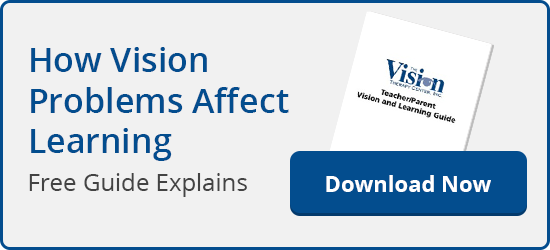
One in four children experience vision problems that are often misdiagnosed as other common learning difficulties. Discover why these issues are referred to as “the hidden disability,” and parents and educators know so little about them.
Meet six-year-old Brooke. Reading was never easy for Brooke. Letters not only jumbled, but disappeared entirely. The print persistently went in and out of focus.
Brooke’s teacher thought she was just being lazy, because Brooke did not tell her teacher, or her parents, what she was experiencing.
“I thought books did that to everyone,” she said.
It is unlikely for children like Brooke with learning-related vision problems to report any symptoms. They believe they see the same as everyone else does, making these children prone to a misdiagnosis of dyslexia, ADD, or just plain laziness.
That is why we refer to these vision problems as “the hidden disability.”
Brooke is far from alone. In fact, research shows about a quarter of children — not to mention, 70 percent of juvenile delinquents — have vision problems that set them behind academically.
Vision Problems are an Epidemic
At The Vision Therapy Center, we consider these vision problems to be an epidemic. And much of our modern-day lifestyle is to blame.
Today, the average child watches 6,240 hours of television before their first day of elementary school. That’s over 6,000 hours that could have been spent engaging in activities that encourage the development of visual skills necessary for kindergarten and first grade level school work.
Many parents and educators do not realize that having strong visual skills means more than clearly identifying letters and numbers on an eye chart.
Vision is a learned skill, just like walking or talking. Children learn to use their eyes and brain together to accomplish daily tasks ranging from reading to catching and throwing a ball.
Much of your child’s perception, comprehension and memory relies on the development of this visual system. If it’s underdeveloped, it could seriously hinder learning and achievement abilities.
So What Can You Do?
1. Get tested. Does your child’s teacher report he or she is performing below his or her potential? Daydreaming in class? Or that he or she should be evaluated for ADD or dyslexia?
Before you assume the worst, have your child tested for a learning-related vision problem. Not all eye exams test for functional vision skills, such as eye tracking, visual memory and depth perception. Developmental optometrists conduct a functional vision test to assess all areas of visual function.
2. Observe. Watch if your child is showing physical or performance clues or symptoms of a learning-related vision problem. If they are, or if they are not performing well in school, schedule a functional vision test. Symptoms include:
Physical Clues —
Red, sore or itching eyes
One eye turning in or out, or jerky eye movements
Excessive blinking, eye rubbing, squinting
Blurred or double vision
Headaches, dizziness or nausea during and/or after reading
Head tilting, closing or blocking one eye when reading
Performance Clues —
Frequent loss of place when reading
Omits, inserts or rereads letters/words
Confuses similar looking words
Failure to recognize the same word in the next sentence
Poor reading comprehension
Letter or word reversals after first grade
Difficulty copying from the chalkboard
Poor handwriting
Misaligns numbers
Holds book too close to eyes
Inconsistent or poor sports performance.
3. Support. Encourage vision screenings and education programs at your child’s school and in your community. We are happy to provide presentations to help parents and educators understand functional vision problems.
If your child is determined to have a functional vision problem, then vision therapy may be the recommended treatment. Vision therapy involves a series of activities designed to improve the development of a child’s visual system. To learn more about vision therapy, click here.
Is there a way to prevent the problem before it happens? Absolutely. Performing a functional vision test before a child enters school is the best way to ensure that their struggles are not misdiagnosed.

